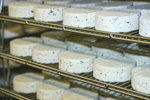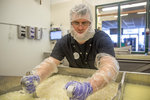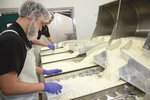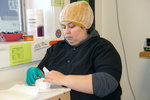When he sees wheels of his company’s cheese for sale at area grocery stores, Derek Jonsson is filled with satisfaction for a job well done.
“I love it,” said Jonsson, who works as the cheese lead at Mt. Townsend Creamery. “I take a lot of pride in that, especially getting feedback from people. It brings me in here everyday and makes it a lot easier to make cheese.”
This item is available in full to subscribers.
We have recently launched a new and improved website. To continue reading, you will need to either log into your subscriber account, or purchase a new subscription.
If you had an active account on our previous website, then you have an account here. Simply reset your password to regain access to your account.
If you did not have an account on our previous website, but are a current print subscriber, click here to set up your website account.
Otherwise, click here to view your options for subscribing.
* Having trouble? Call our circulation department at 360-385-2900, or email our support.
Please log in to continue |
|




When he sees wheels of his company’s cheese for sale at area grocery stores, Derek Jonsson is filled with satisfaction for a job well done.
“I love it,” said Jonsson, who works as the cheese lead at Mt. Townsend Creamery. “I take a lot of pride in that, especially getting feedback from people. It brings me in here everyday and makes it a lot easier to make cheese.”
Jonsson and a small staff of fellow cheese crafters work for hours on end to make sure the artisan cheeses they craft are delicious and unique.
“I love creating food,” Jonsson said. “I have always loved cooking. I have always loved the process of making food, and I have always been interested in science as well, and cheese is a perfect intersection between science and creating food. This job just naturally fit into those two things for me. It has worked out ever since.”
The creamery is located at 338 Sherman St. in Port Townsend. It is owned by Ryan Trail and Matthew Day, who co-founded the business about 13 years ago.
The micro-creamery currently employs about 17 workers, who craft about 130,000 pounds of cheese annually, Trail said.
“We take in about as much milk in a year as Tillamook takes in half a day,” he said. “As far as artisan creameries in Washington, we are probably the second largest one.”
The creamery specializes in soft-ripened cheeses such as Camembert and Seastack.
“There is a penicillium candidum mold that grows on the rind of the cheese,” Trail said. “As it ages, that mold breaks down the cheese and changes the texture and it changes the flavor. It gets gooey. It starts out a little chalky in the center, but it ripens from the outside in. When it gets quite ripe, it will be soft all the way through.”
The entire process is closely monitored and takes up to eight weeks to complete, Trail said.
“I like the blend of art and science in what we are doing, because it is very technical,” he said.
All about the science
Although an age-old art, crafting cheese in the modern world involves a serious amount of science to manipulate the biological elements of the process.
“With this, it is totally out in the environment, so you have humidity and airflow and all the things that are in the air,” Trail said. “This is a very hands-on process.”
Making a good cheese is reliant on the quality of the milk, Trail said.
“We get our milk from Maple View Dairy in Sequim right off of Sequim Bay Road,” he said. “They are not organic, but they use good agricultural practices.”
After the milk is trucked in, it is checked for quality, Trail said.
“It is raw when we receive it,” he said. “They bring a tanker truck straight from the farm to here. We hook some hoses up to it, and we have some hard piping that sends it back to our storage tank.”
Before cheese can be made, the milk is pasteurized by bringing it up to a temperature of 145 degrees, Trail said.
“What we are trying to kill are pathogens, things that make people sick like E. coli, salmonella Staph aureus or listeri,” he said. “After pasteurization, we cool the milk down and then we add in our own bacteria. There is still some in the milk, but we are putting in what we want to be in it.”
The company makes about 10 varieties of cheese that all begin with the same milk but include different cultures of bacteria depending on the recipe, Trail said.
“We have our own blend of all different cultures that we use,” he said. “There are the starter cultures which takes the sugar and turns it into lactic acid. Then there are cultures that we add in to develop the rind. We add different yeasts and bacteria and molds and all different strains.”
Each culture has different parameters, Trail said.
“One will do more to break down fat,” he said. “Another one will be more to break down proteins, or it will be a milder strain, or for a longer shelf life. There are all these things we fool around with culture-wise.”
Food preservation
“One of the fundamentals of cheesemaking is we are trying to take milk, which is very perishable and turning it into something that has a good shelf life,” Trail said. “With a lot of food preservation, one of our strategies is creating acidity. That is lactic acid. The next thing is we are trying to remove moisture. When we start out with 1,200 liters of milk in our vat, which is about 315 gallons, we will get maybe 10 percent of the weight of that milk out as cheese.”
After the milk has been pasteurized and sprinkled with the starter culture, the next step is to add rennet, an enzyme that curdles the casein protein in milk, Trail said.
At this point, the milk has the consistency of a watery yogurt, Trail said.
“It is a little bit lighter, but it is not fluid,” he said.
Once the curds form, the cheesemakers cut and stir them to help expel water, Trail said.
“With this cheese, we will be cutting it into little cubes that are roughly a centimeter cube,” he said. “Then, you will see this yellow liquid start coming out from it. As the bacteria are acidifying the cheese, it is pumping whey out of the curds and the curds are shrinking. About 90 percent of the volume of liquid will go out as whey.”
The whey, which does not coagulate, is collected and sold to area farmers to be used as animal feed, Trail said.
“It is relatively high in protein,” he said. “The whey proteins come off and a lot of pig farmers come and haul the whey off. We have about a 1,000-gallon storage tank with a pump hooked on to it.”
The tank is filled after about three batches of cheese, he said.
“We have people coming in all the time.”
Molding the cheese
Next up, the cheese curds are poured into cylindrical plastic molds on a stainless steel table.
“Each one of these vats will then form 240 wheels of cheese when we tip it up,” Trail said.
The cheese is then placed in a storage room.
“It is sitting in there overnight and we are controlling the temperature all the way through until the next morning,” Trail said. “The next day, the cheese comes out of the molds, and will have shrunk in size to about two inches in height, he said. It was four inches (tall) to begin.”
The wheels are then salted.
“It helps preserve the cheese,” Trail said. “You have to have the right amount of salt mixed in. The cheeses at that point are still about 50 percent water, and the salt helps pull the moisture out. The salt permeates in, and then we put it in this special room that has air circulation and that helps dry it off.”
The cheese is next placed in a ripening room where it sits for the next nine days before being packaged by Kodi Semon and Maria Taberna, who each will wrap up to 720 wheels per shift.
“It is the same motion over and over so you develop some muscle memory,” Semon said. “We can sing and chat and wrap.”
Semon, who has worked at the creamery for the past six months, said she is keen on learning the whole process of making cheese.
“I have always been in the food service industry, and I love cheese,” she said. “I love eating cheese. I am super interested in the science behind it and learning the process. It is really interesting to see how they are constantly adding things, and changing the processing to make it work better. It is cool to see how they are doing it.
Once wrapped, the cheese continues to ripen.
“It takes about 10 days for the mold to cover the cheese, and so the cheese they are wrapping was made about 10 days ago,” Trail said. “It is fully covered in mold, but it is still quite firm. They are all generally a little bit different. Six to eight weeks from now is when they will be totally ripened.”
The final step is to be shipped off to grocery stores for purchase.
A cheesy path
Trail decided to open up the creamery after working for New Belgium Brewing Company in Fort Collins, Colorado.
“I started there when we were bottling beer by hand,” he said. “That was my job when I was in college.”
Later Trail became the plant engineer, which taught him the technical expertise he needed to operate a food processing facility, he said.
Trail also got hands-on training at a creamery in Colorado.
“I did have a friend in Colorado who started a creamery probably 20 years ago,” he said. “They were actually a couple who worked at the brewery together, and her father was a German cheesemaker. He taught them and I helped him with his equipment setup and that’s how I got interested in it.”
He later took a cheesemaking class through Washington State University Extension
“We made cheese at home for a while,” Trail said. “It is hard. We couldn’t do any aged cheeses. Mostly we were making mozzarella and stuff that is pretty simple to make. Without the right tools it is really not easy to do on a home scale. We threw away a lot of bad cheese at the beginning. We also did have some successes early on, too. It is a matter of making improvements along the way.”
Mastering the craft
A decade later, and with a full plant at his disposal, Trail said he still seeks to become a more proficient cheesemaker.
“We are still making improvements,” he said. “There is still tons to learn. There is so much information out there and tons of technical information. It is definitely not a static thing. The milk changes throughout the year. They say you have to make cheese for at least 10 years to even see the realm of what things come your way. We are starting to feel a little bit more comfortable with that.”
For more about the creamery, visit its website or call 360-379-0895.